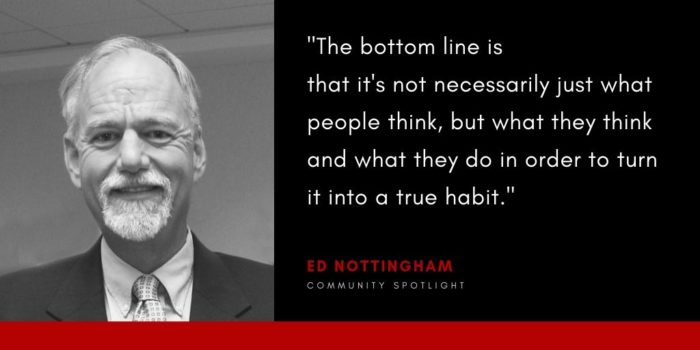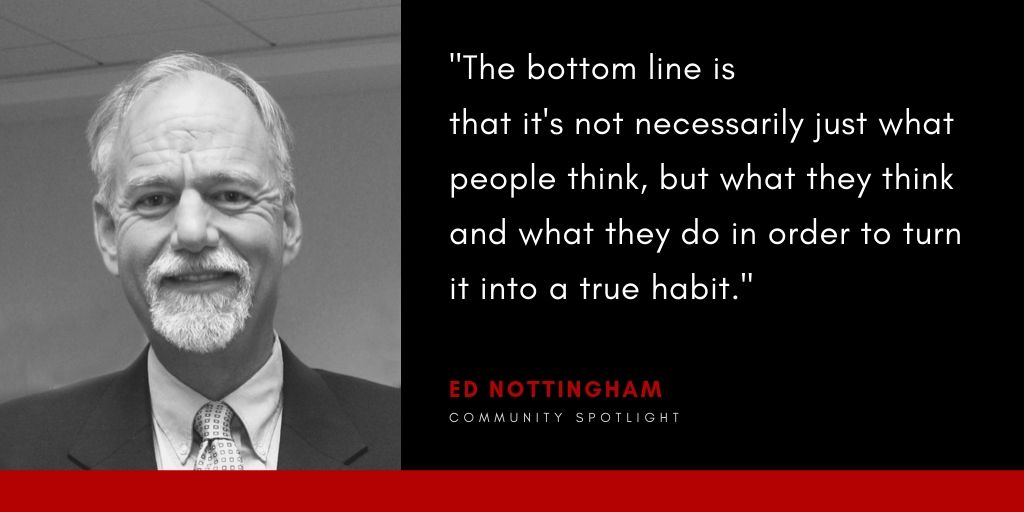
Welcome to Community Spotlight, a place where we get to highlight the impressive achievements you have all made.
This week, we’re talking with one of our Founding Members, Ed Nottingham, PhD, ABPP. Ed has been involved in the community for a number of years, and the experience has been transformational. This past year, he finally decided to take the plunge and try out our newly released The ONE Thing Planner. We talk shop about the planner, changing behaviors, goal setting, and learning to narrow down on your ONE thing for each day.
Madelaine Davis: Why did you pick The ONE Thing Planner and how has it differed from other planners you’ve used?
Ed Nottingham: Primarily, I picked it because it sounded like a novel idea. I had downloaded the prototype, and thought I would give the actual planner a try. I used Franklin Covey for many years, but then moved to Outlook.
For me, I like to use a combination of my digital calendar – Outlook – and a paper planner.
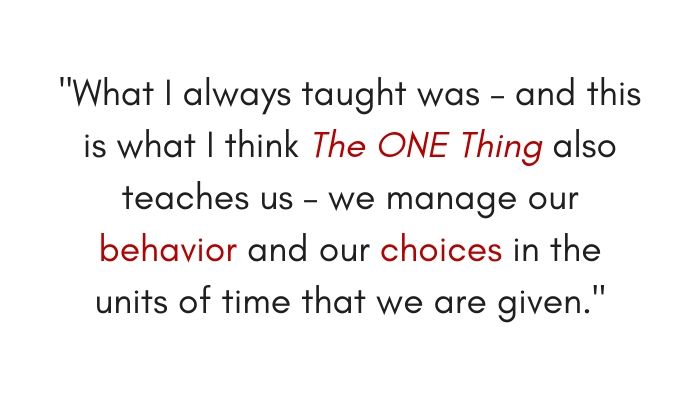 MD: Do you feel like using the planner which asks you to know what your one thing is for the day, has changed the way you think about time, time management, and how you use your time on a daily basis?
MD: Do you feel like using the planner which asks you to know what your one thing is for the day, has changed the way you think about time, time management, and how you use your time on a daily basis?
EN: What I always taught was – and this is what I think The ONE Thing also teaches us – we manage our behavior and our choices in the units of time that we are given. For me, that’s what the planner does. It really reminds me what are the behaviors that I will engage in this morning, today, whatever, in order to accomplish that one thing that will make other things easier or unnecessary. So, it’s really helped me to be more focused in how I’m engaging with those time units that I’ve got.
MD: How has it changed the way you think about time and time management? And what has been a big takeaway for you switching back to partially using a paper planner?
EN: A big takeaway for me, using the planner, has been understanding what my ONE thing for the day is. So, for example, Shannon Carter and I worked together on the ONE Thing training stuff and we’re coming to Boston in October for certification. She was doing a program, needed a lot of help. But on my Monday and Tuesday, I was scoring over 50 emotional intelligence assessments. So, when she came to me, I said, “I’m sorry Shannon, I wish I could. But my one thing today and tomorrow is scoring, printing, reviewing over 50 emotional intelligence assessments.”
So, having that top line and I also made… I posted this on the community, but I have these little abbreviations that I’ve added. So, P stands for planning. PD is programmed to delivering. A is administrative work. M is meetings. R is just a reminder. So, I can see what I’m getting done, and how often. There are also spots for a 66 day challenges, and for my most recent one — I’m not opening Outlook until I have focused on and hopefully completed my one thing for that day.
I don’t even open Outlook. I guess I’m 10 days in at this point. So that’s been the biggest benefit to me, to be able to open that up, look at that and know – What’s my one thing today?
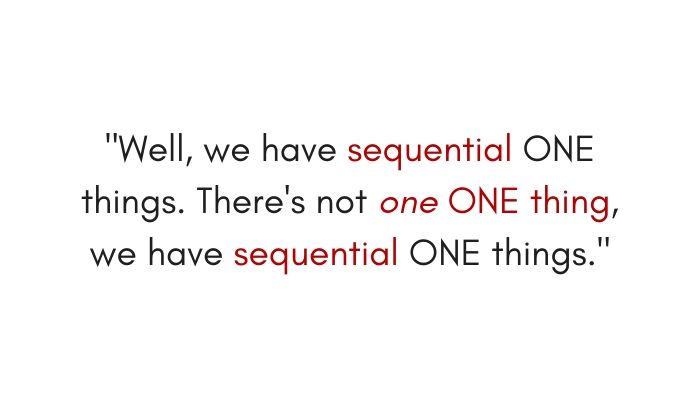 MD: So for you the planner functions more as a tool to help implement habits and behavioral changes over time that have an impact on your life, as opposed to just time management per se, since you don’t really manage your time?
MD: So for you the planner functions more as a tool to help implement habits and behavioral changes over time that have an impact on your life, as opposed to just time management per se, since you don’t really manage your time?
EN: Yeah. My digital calendar is there with all the reminders and all the specifics and where I’m meeting, I’m looking at my planner and how many days I have. And I actually put a photo of it on the community. But you know, I’ve got the top things, EI assessments are due today. I did have a visit with a guy who came into town. Then I had some other things, print reports and stuff like that. But this is really my focus on my behavior and what I’m going to be doing and accomplishing each day.
MD: Yeah. Do you mind if I ask you what your one thing for the year is?
EN: Well, we have sequential ONE things. There’s not one ONE thing, we have sequential ONE things.
MD: Yes.
EN: So again, those are really focused on my deliverables within the company, one of which has been to complete the certification training so we can start doing some internal work as well. So, I’ve got things like annual goals. Our number one priority is to plan, organize and deliver our coaching and emotional intelligence programs for new leaders. And then I have other things down from there. So, I approach it very, very sequentially.
MD: You said earlier that the planner helped you prioritize on a daily basis –have you felt that’s had an impact on your goals for the year, or how you set and plan for them?
EN: I don’t know if you know anything about my background and relationship with The ONE Thing. But I was part of the Founding Members club when I joined, and then the Living Your ONE Thing community, I was sending Geoff all these snarky little emails about how this is great if you work for Keller Williams and you’re self-employed or you do whatever. But I work for a Fortune 100 company, and my world is not my own. That, again, people are dumping things on my plate all the time. And what’s been interesting is that sort of transition that I’ve been able to make that I think even… And that’s one thing we emphasize when we’re doing our programs internally that we all understand that we have more than one thing. It’s not a literal one thing.
We also have family, we have health, we have finances – the seven circles. But being able to actually embrace that idea that, yes, it can work for anyone. This is where I think the planner for me has really come into play that I have sequential ONE things. When I can open that up first thing every morning, look at it and know here is my one thing for that day that will lead to the weekly accomplishment of a goal that will lead into the monthly accomplishment of the goal, that will lead to the annual accomplishment of those specific goals that are listed.
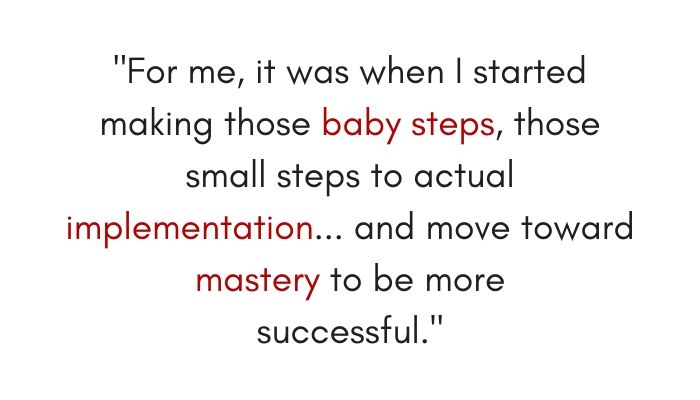
MD: So, you mentioned that it was a subtle mindset shift over time, how you thought about time and your ONE thing, after joining the community. Did you have any other kind of breakthroughs or sudden realizations that going through all this training, using the planner, implementing all these tools have like led you to?
EN: I also was in clinical practice, I worked with a lot of people who are in recovery and they learn all these little pithy sayings. One of which is, “It works when you work it.” So, I don’t care how long people have been a member of the community or whether they read the book or whatever it might be. For me, it was when I started making those baby steps, those small steps to actual implementation. Of being able to say, “Where are we at this point?” And being able to really start implementing and move toward mastery to be more successful. The bottom line is that it’s not necessarily just what people think, but what they think and what they do in order to turn it into a true habit. So, another one of the big pluses, I think of The ONE Thing, is the 66-day challenge. Because it’s a great tool for implementing change. Lasting change. Which, you have space for in the planner.
Again, it’s going to be individualized in term how people find value, but I know again, just like for me, being able to open it up first thing and look at it, what’s on the top line. That top line is my one thing at least for the next few hours, and that makes a difference.

